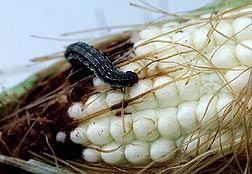
Sweet corn season is here, and there’s nothing like eating freshly harvested ears – unless you find a worm when peeling back the husks! That unwanted intruder is usually the corn earworm, Helicoverpa zea, a caterpillar that eventually grows to 2 inches long. They vary in color, and may be green, brown, pink, black or various shades between these colors, with light and dark stripes along its sides and back. The head is always a yellow or light brown color, without any spots.

The adult corn earworm is a grayish-brown, night-flying moth with a wingspan of about 1½ inches. Female moths prefer to lay their eggs on fresh corn silks, but will also choose buds and growing tips of young corn if silks aren’t available. The tiny, light yellow eggs are laid singly. Females can lay up to 1000 eggs during their lifetime. By the time the eggs hatch in a few days, they have turned to a dark brown. The little caterpillars crawl down the silks to the end of the ear to feed on the maturing corn kernels. Since they are cannibalistic, you typically will only find one in each ear of corn. After about 2 weeks of feeding, the caterpillar crawls out of the ear and drops to the ground where it burrows a few inches into the soil to pupate.
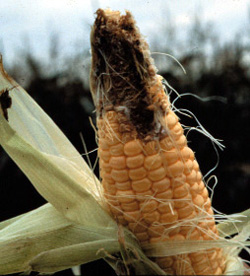
Corn earworm spends the winter in the pupal stage but they rarely survive our harsh winters. In most years, a new infestation of moths migrates into Wisconsin on winds blowing up from southern parts of the US. They typically arrive here in late June and only affect very early sweet corn. The second generation in mid-August to early September is generally more damaging to sweet corn.
There are a number of options for controlling corn earworm in the home garden:
- There are some sweet corn varieties that show resistance to corn earworm damage. These include ‘Country Gentlema’n, ‘Stay Gold’, ‘Victory Golden’, ‘Silver Cross Bantam’, and ‘Silvergent’.
- Plant mid-season varieties that will mature between moth flights so the ears will be less likely to be injured.
- Industrious gardeners can prevent moths from laying eggs on their corn by applying 20 drops of mineral oil with a medicine dropper to the silks inside the tip of ear after the silks have wilted (3 to 7 days after silks first appear).
- Chemical insecticides can also be used to protect the ears but once the caterpillar has entered the ear, there is no effective control. To be effective, you need to completely cover the end of the ear so that when the eggs hatch, the young caterpillars will immediately contact a lethal dose of insecticide. Treatments must be reapplied every 3 to 4 days from when silks first appear until they become brown. Consult your local county Extension office for recommendations of insecticides registered to control corn earworm in the home garden.
- If you’d rather not treat the ears, you can always just cut off the damaged parts of infested ears, as the portion not fed on by the caterpillar is still perfectly good.
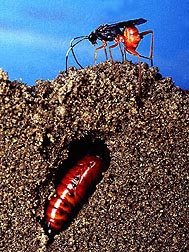
There are a number of natural enemies that attack corn earworm eggs. A number of tiny Trichogramma, chalcid and braconid wasps parasitize the eggs, while minute pirate bugs (Orius spp.) attack the eggs and there is a virus that may infect and kill the eggs. There are also wasps that attack corn earworm larvae and pupae, however, these beneficial insects are not numerous enough to provide acceptable control.
Corn earworm has a wide range of tastes besides just corn. Other vegetables it will consume include tomatoes, beans, cabbage, and soybeans. It is referred to as the tomato fruitworm when found on tomato, and the cotton bollworm when found on that plant. Corn earworm prefers corn, but late in the season when corn plants are not as attractive, it may damage tomatoes and snap beans by eating into the fruits or pods.
Occasionally other insects, particularly the European corn borer, may also be found in sweet corn ears. Control of these is the same as for corn earworm.
– Susan Mahr, University of Wisconsin – Madison
February, 2025





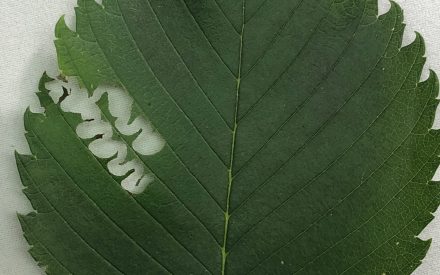 Elm Zigzag Sawfly
Elm Zigzag Sawfly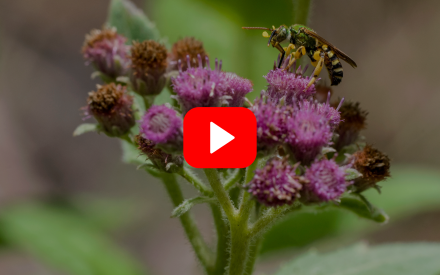 ▶ Watch: Pollinator Gardens: Plant Selection and Garden Care
▶ Watch: Pollinator Gardens: Plant Selection and Garden Care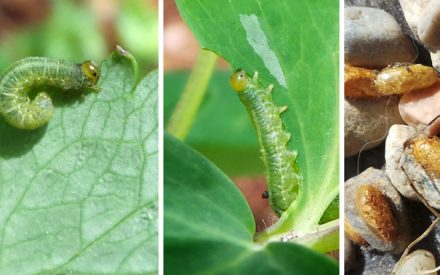 Strategies for Identifying and Managing Insect Pests
Strategies for Identifying and Managing Insect Pests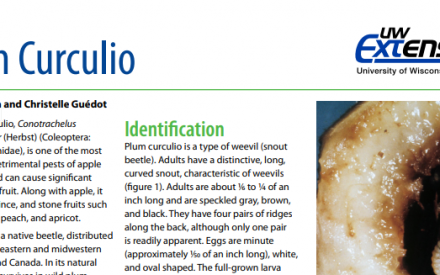 Plum Curculio
Plum Curculio


